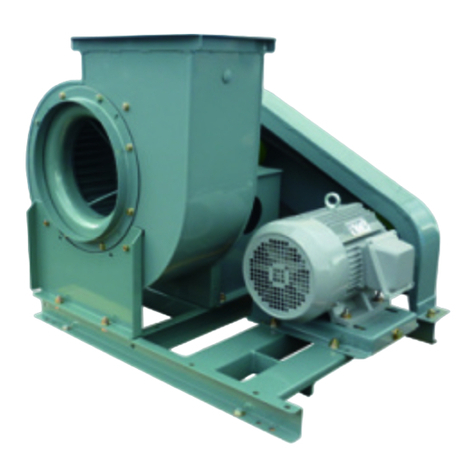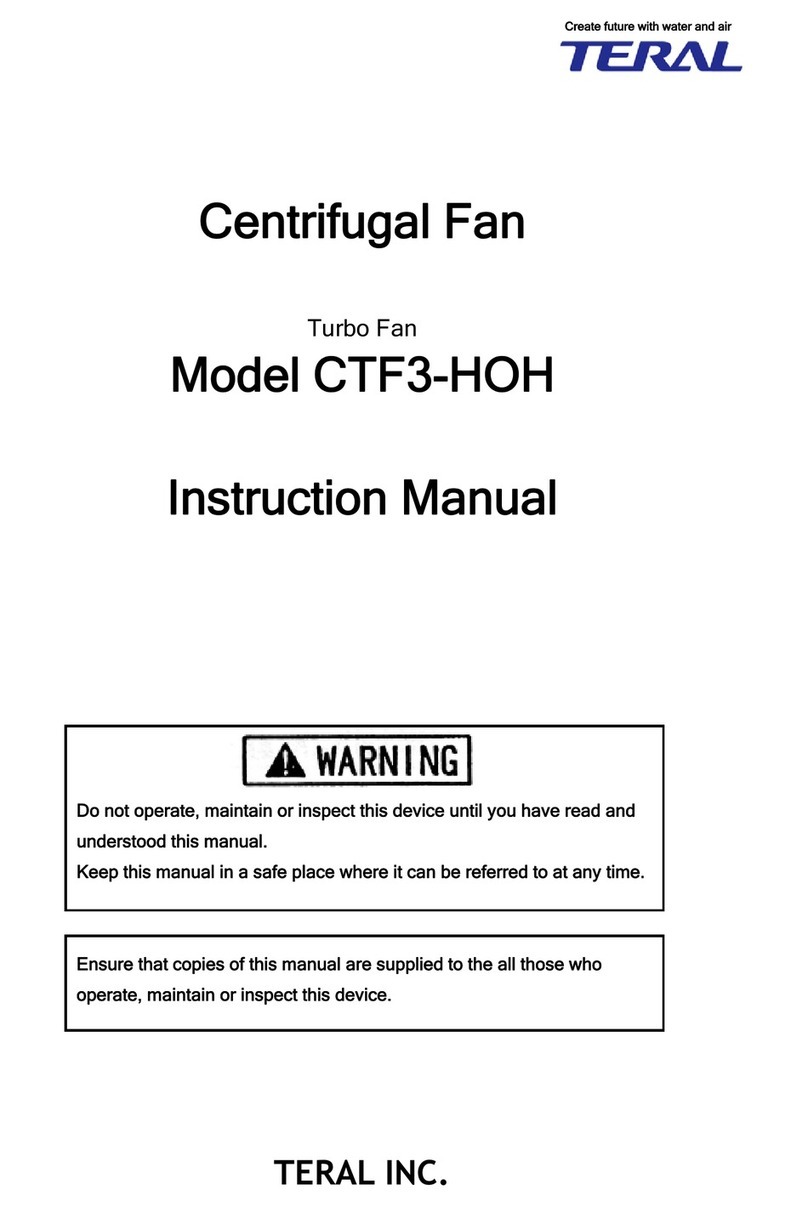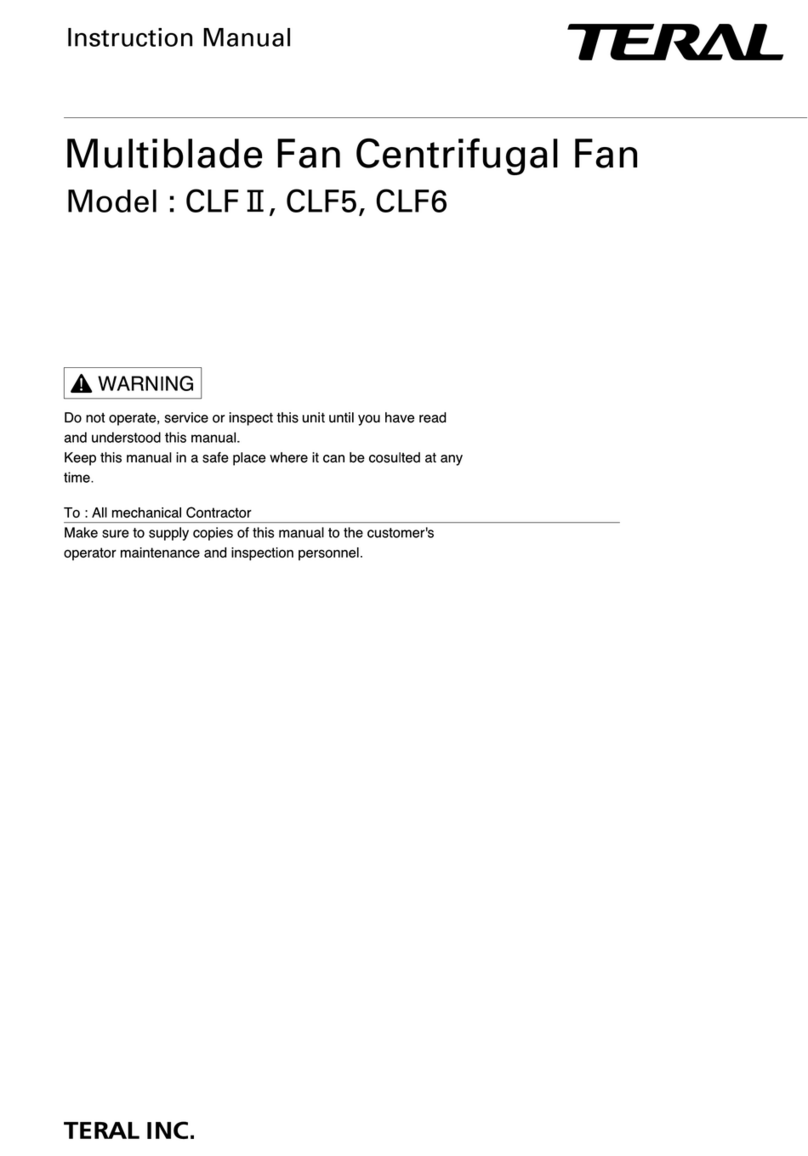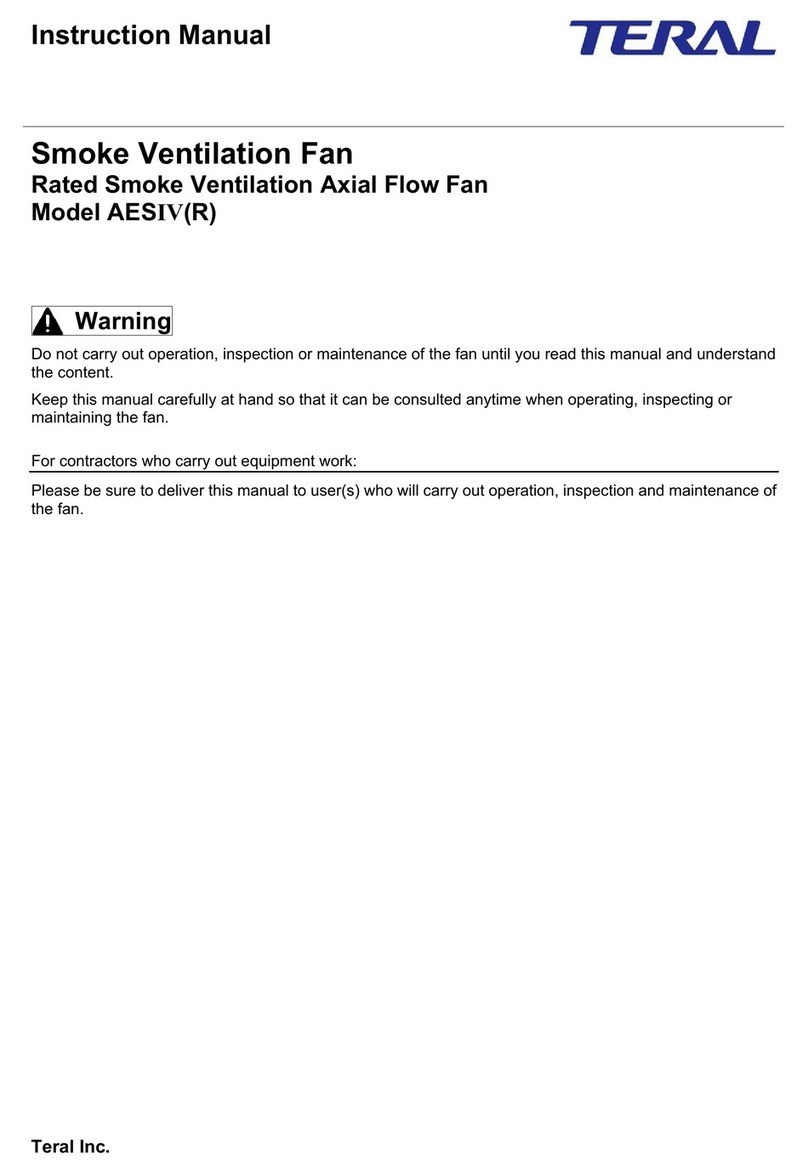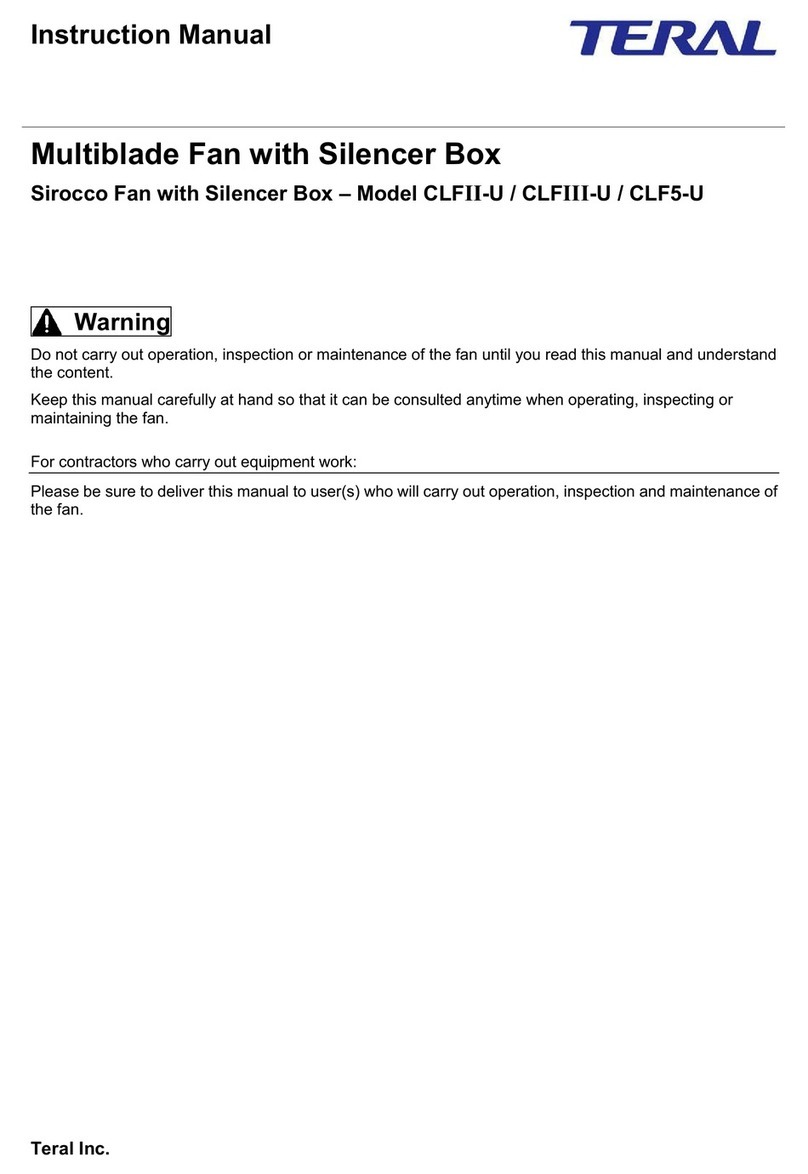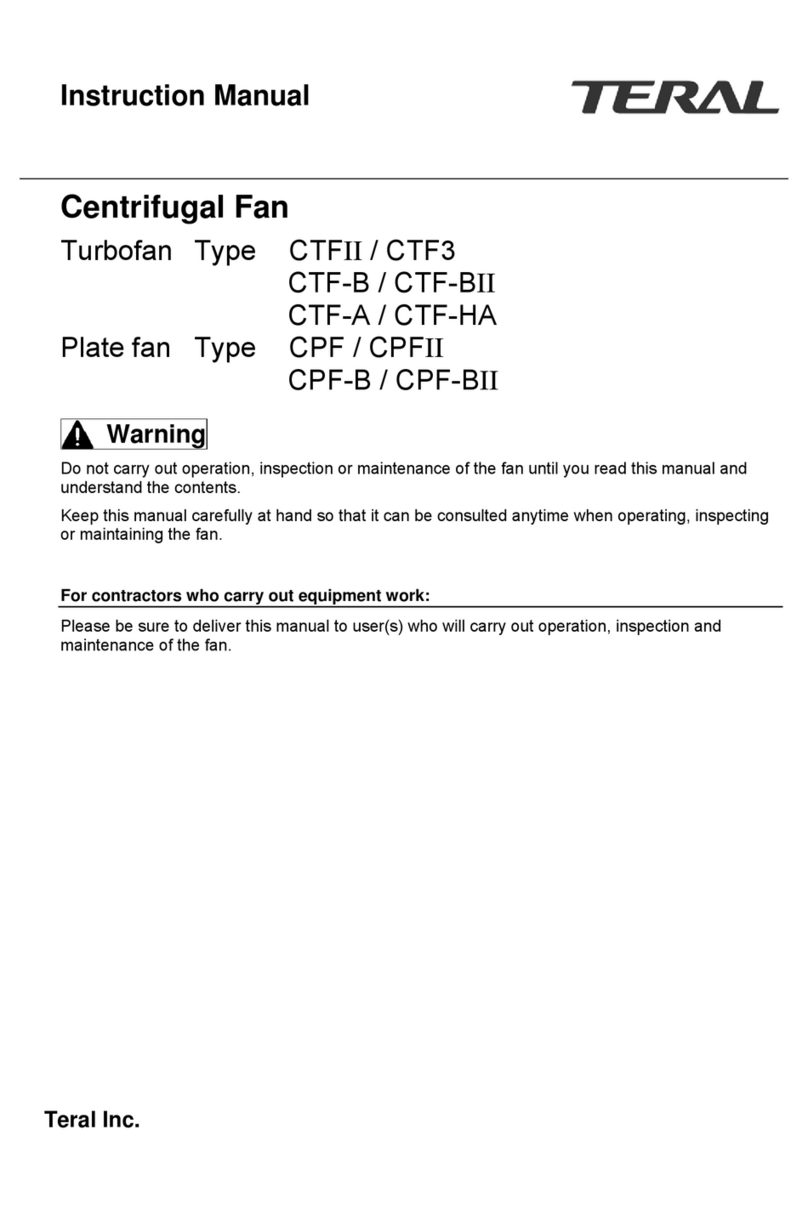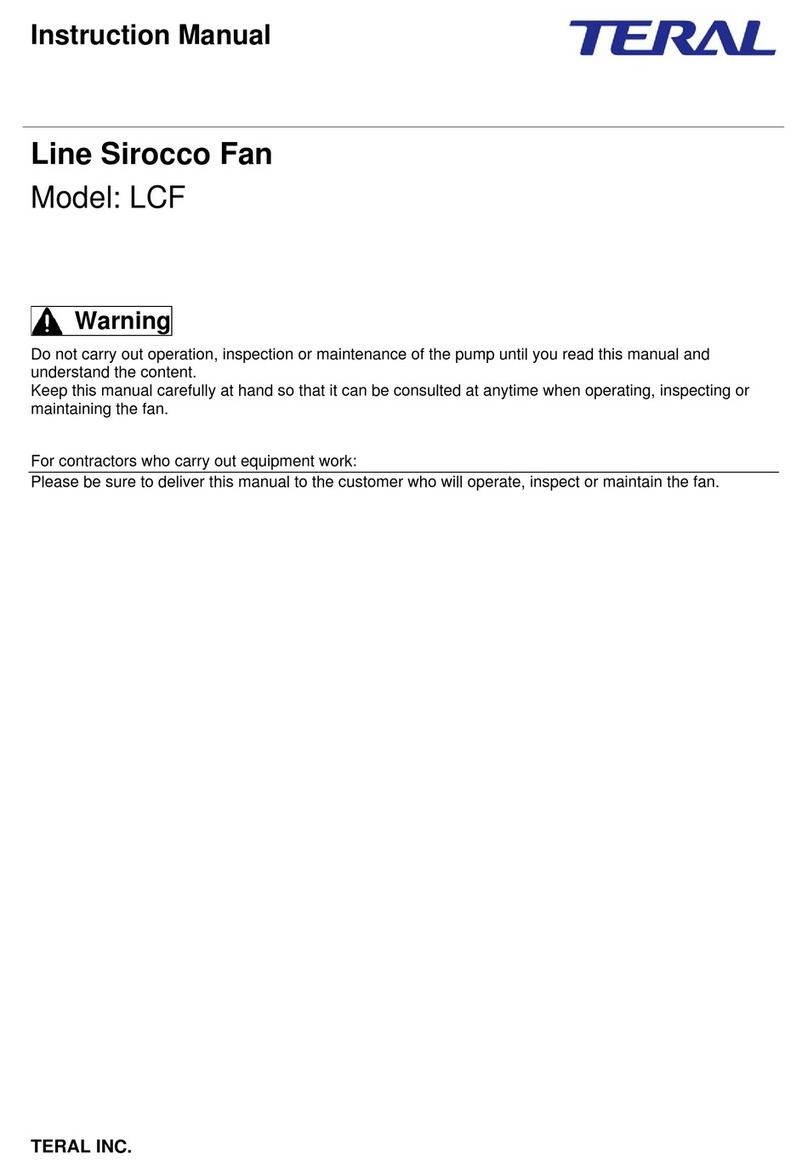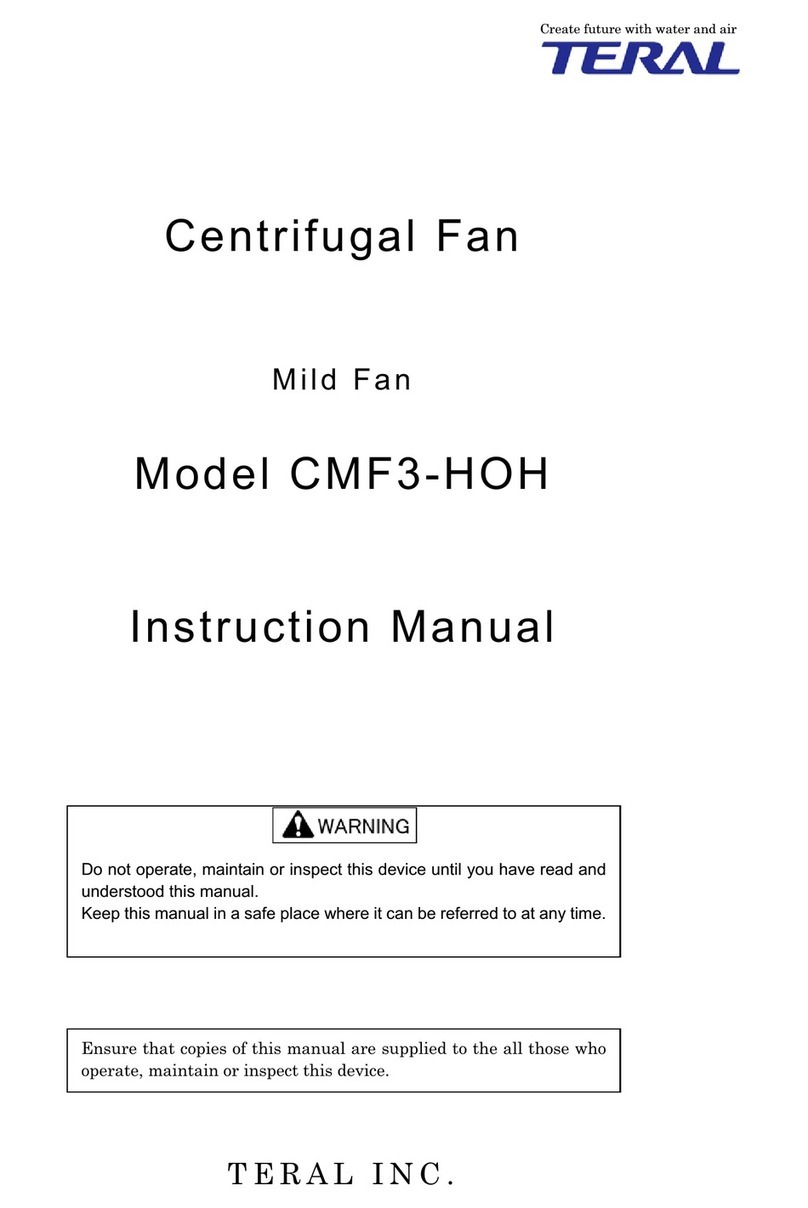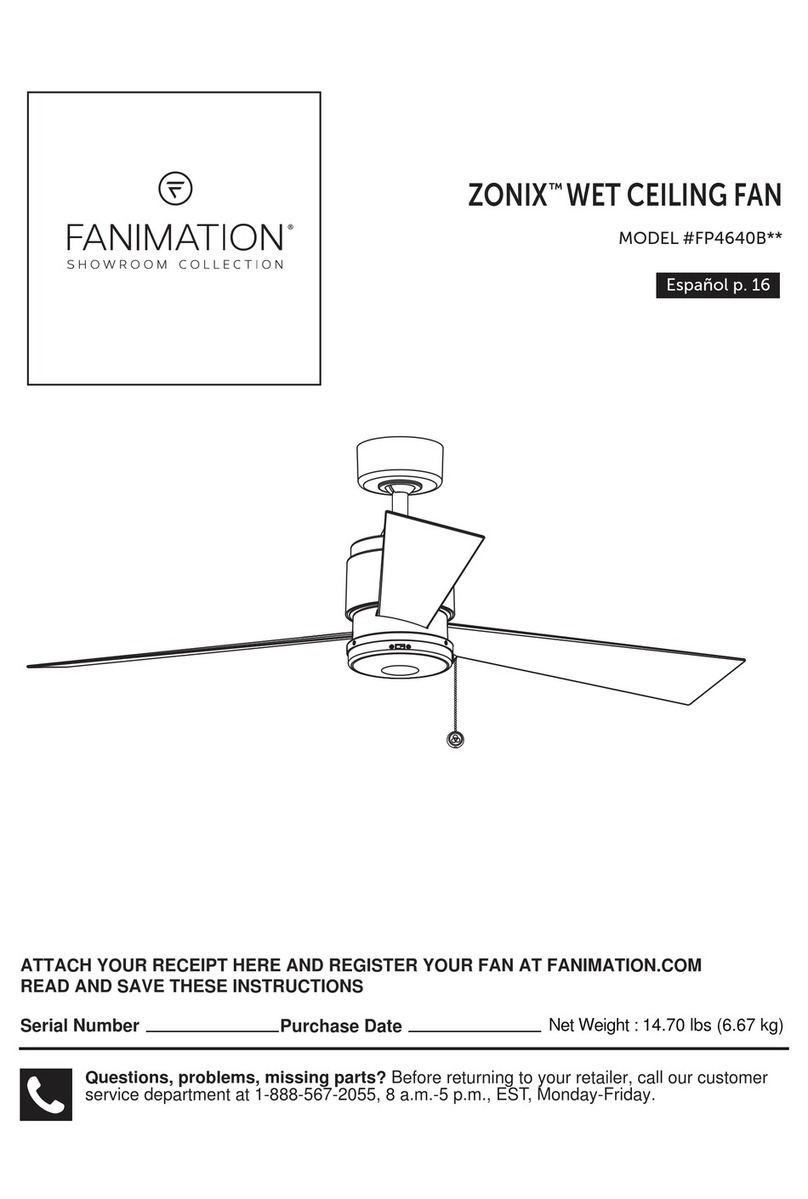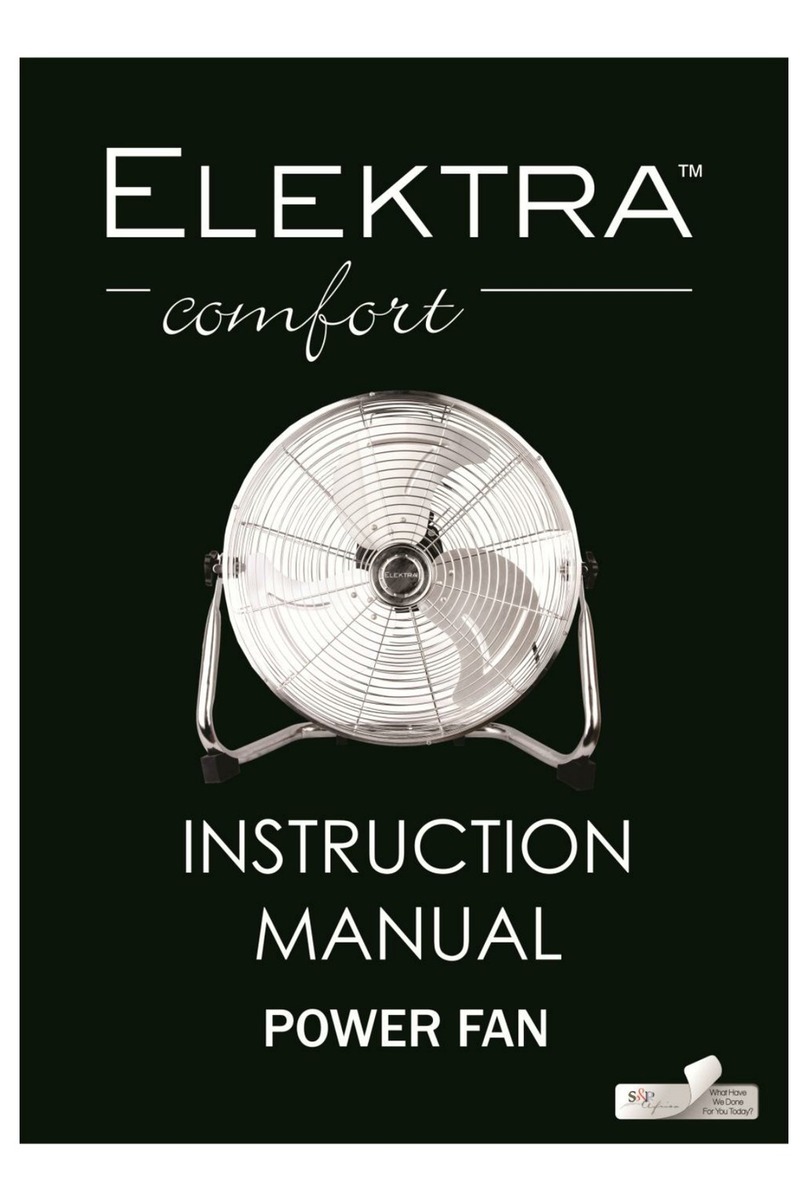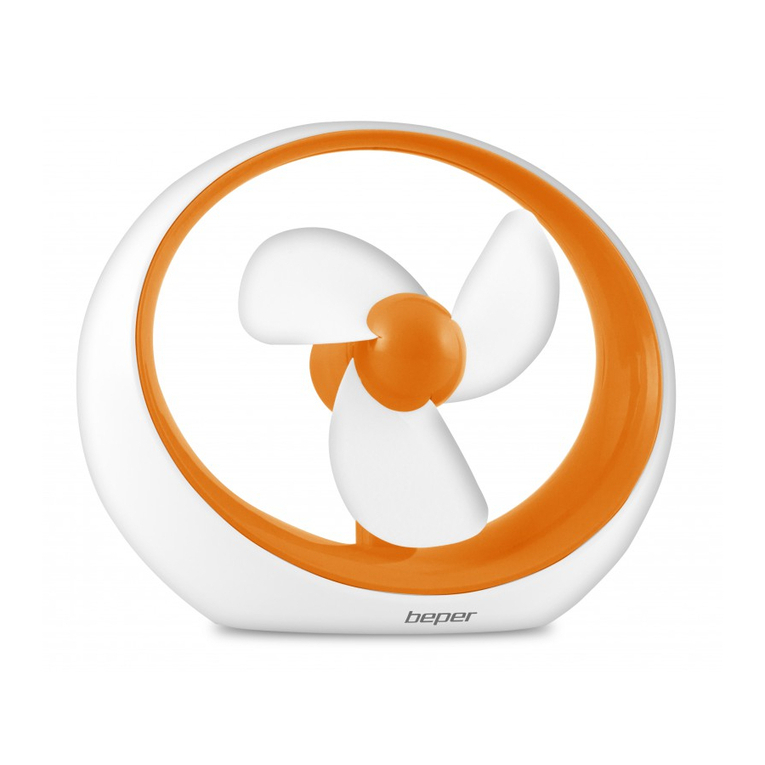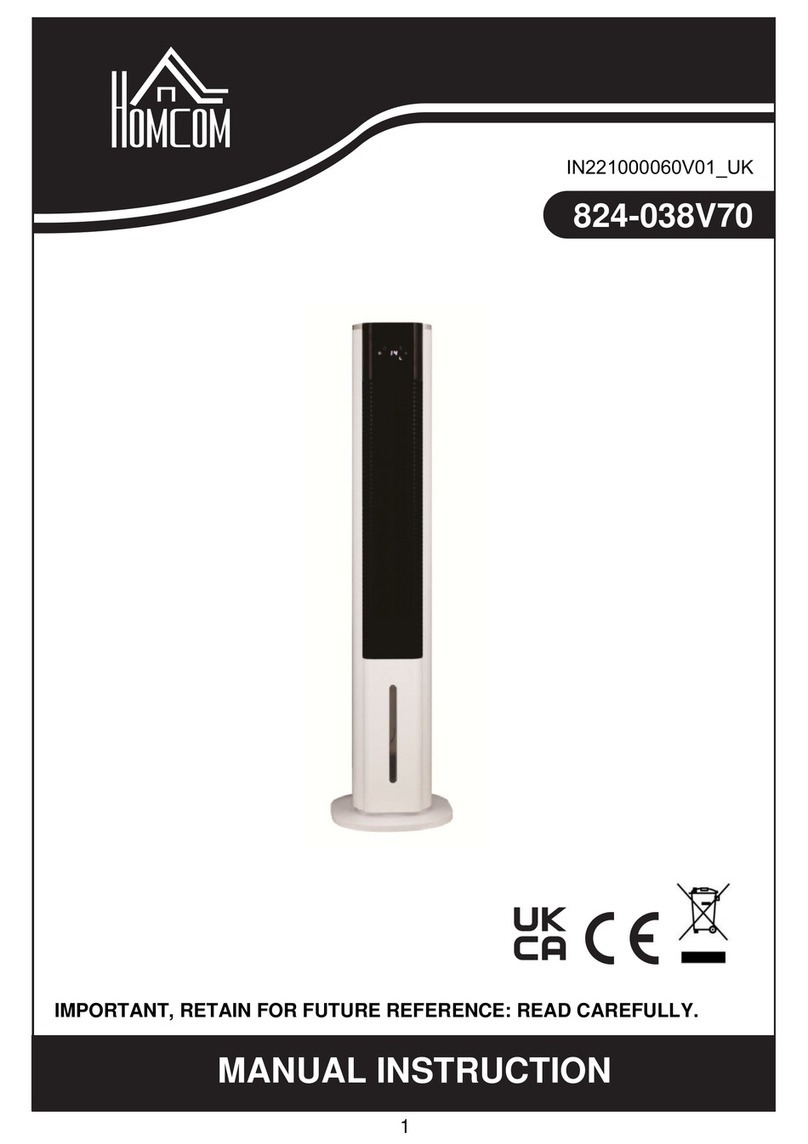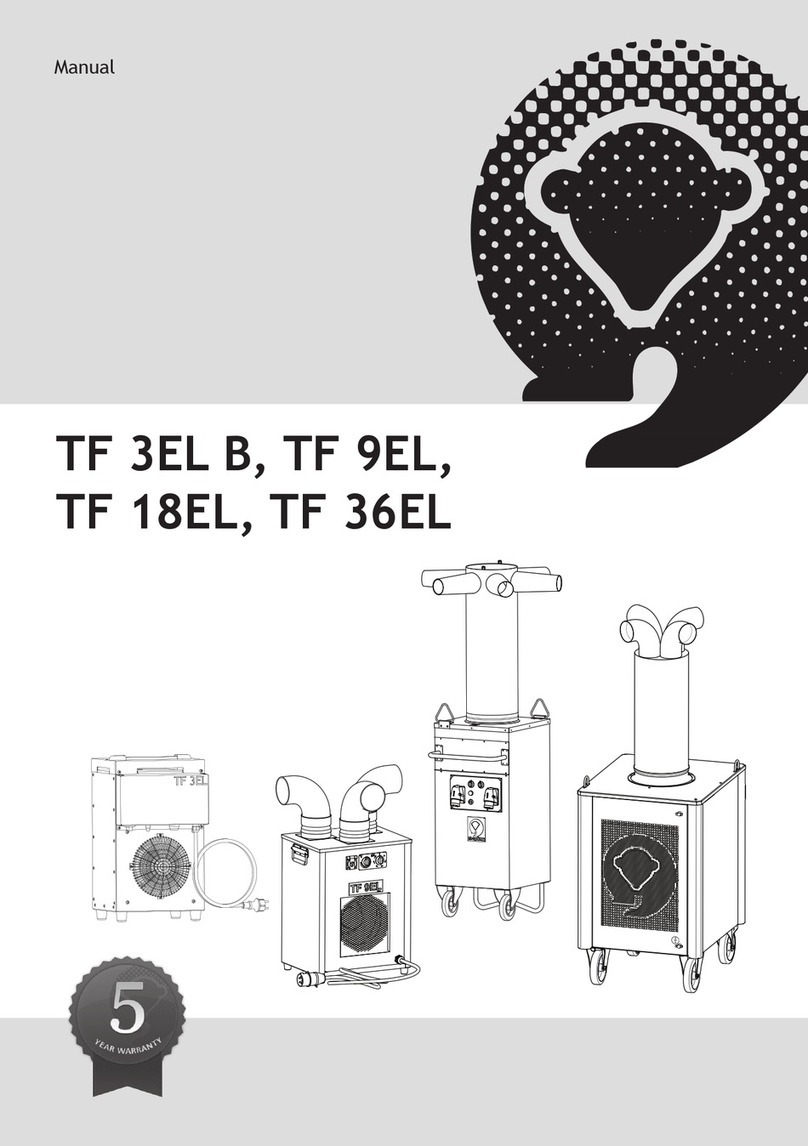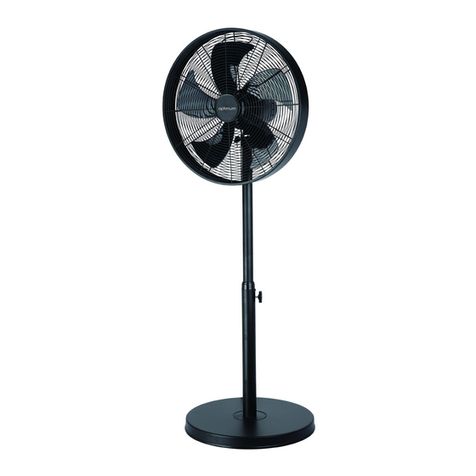Teral ALF-US User manual

Instruction Manual
Diagonal Flow Fan with Silencer Box
In-line Fan with Silencer Box – Model ALF-US / ALFII-U / ALF-UII
Warning
Do not carry out operation, inspection or maintenance of the fan until you read this manual and understand
the content.
Keep this manual carefully at hand so that it can be consulted anytime when operating, inspecting or
maintaining the fan.
For contractors who carry out equipment work:
Please be sure to deliver this manual to user(s) who will carry out operation, inspection and maintenance of
the fan.
Teral Inc.

Limited warranties
1. In the event of failure or breakage under the proper use of the product during the warranty period,
equipment supplied by Teral Inc. (hereinafter referred to as TERAL) will be repaired or replaced
free of charge within the scope of the relevant part, provided that such failure or breakage is
attributable to inadequacy of the design or workmanship of the equipment.
2. The warranty mentioned in the above clause shall be only the mechanical warranty of the
defective part, and shall not cover any expenses or other damage arising from the failure or
breakage.
3. In the event of the following failures and breakage, the costs of the repairs shall be for the account
of the user.
(1) Failures and breakage attributable to equipment that was not delivered by TERAL
(2) Failures and breakage occurred after the expiration of the warranty period
(3) Failures and breakage caused by disasters or force majeure, such as fire, acts of God or
earthquakes
(4) Failures and breakage resulting from repairs or modifications made without the consent of
TERAL
(5) Failures and breakage occurred when parts other than those designated by TERAL are used
4. TERAL shall not be liable for the damage caused by incorrect or reckless use of the fan. Cost and
expenses incurred for sending engineer(s) in such a case shall be borne by the user.
5. If the cause of the failure is unclear, necessary actions shall be determined through mutual
consultation.
I

Purpose of this manual
The purpose of this manual is to provide the user with detailed information necessary to properly
operate, maintain and inspect the fan.
This manual contains the following information and is intended for persons experienced in the
operation of fans, or for those who have been trained by such experienced persons. Only
qualified personnel such as electrical engineers are allowed to carry out the electrical wiring
work.
Contents
Limited warranties .................................................................................................................................. I
Purpose of this manual.......................................................................................................................... II
Contents ................................................................................................................................................ II
1. Safety precautions
1.1 Types and meanings of warning terms................................................................................ 1-1
1.2 Safety precautions ............................................................................................................... 1-1
1.2.1 Precautions for installation ........................................................................................... 1-1
1.2.2 Precautions for operation ............................................................................................. 1-1
1.2.3 Precautions for maintenance and inspection ............................................................... 1-2
1.3 Location of the warning labels ............................................................................................. 1-2
2. Configuration and overview of the fan
2.1 Structure and part names of the fan .................................................................................... 2-1
2.2 Specifications of the fan....................................................................................................... 2-2
3. Installation
3.1 Before using the fan............................................................................................................. 3-1
3.2 Precautions for storage........................................................................................................ 3-1
3.3 Precautions for the location of installation........................................................................... 3-1
3.4 Installation............................................................................................................................ 3-2
3.5 Precautions for connecting the ducts .................................................................................. 3-2
3.6 Precautions for wiring work..................................................................................................3-3
4. Preparation for operation
4.1 Points to be checked before test running ............................................................................ 4-1
4.1.1 Checking the electrical system..................................................................................... 4-1
4.1.2 Checking the fan system .............................................................................................. 4-1
5. Operation
5.1 Precautions when starting the fan ....................................................................................... 5-1
5.2 Precautions during the operation......................................................................................... 5-1
5.3 Precautions when stopping the use..................................................................................... 5-1
6. Maintenance and inspection
6.1 Daily inspection.................................................................................................................... 6-1
6.2 Periodic inspection............................................................................................................... 6-1
7. Troubleshooting
7.1 Troubleshooting ................................................................................................................... 7-1
II

1. Safety precautions
1.1 Types and meanings of warning terms
This instruction manual divides precautions into the following four categories according to the
level of hazards (or the severity of the accident).
Be sure to understand the meanings of the following terms and comply with the content
(instructions) of the instruction manual.
Warning Term Meaning
Danger
Indicates an imminently hazardous situation. Failure to observe the
procedures or instructions will result in death or serious injury.
Warning
Indicates a potentially hazardous situation. Failure to observe the
procedures or instructions may result in death or serious injury.
Caution
Indicates a potentially hazardous situation. Failure to observe the
procedures or instructions will result in minor or moderate injury or cause
damage to equipment or devices.
Note Indicates information that is in particular to be noted or emphasized.
1.2 Safety precautions
1.2.1 Precautions for installation
(1) Install the fan considering the center of gravity and weight.
(2) Install it according to the instruction manual.
(3) Do not install it anywhere exposed to direct flame or high temperature.
(4) Do not install it anywhere with high humidity, such as a bathroom.
(5) Do not install it in any places where toxic gases are produced from acids, alkalis, organic
solvent, paint or other substances or where corrosive gases are produced, for example in
machine shops or chemical plants.
(6) Install the outdoor air intake in a position far away from the exhaust vents of combustion gas,
etc.
(7) Be sure to install a ground fault interrupter to the main power.
(8) Only qualified personnel such as electrical engineers are allowed to carry out the electrical
wiring work. Before working, be sure to turn off the main power.
(9) Do not forcibly bend, pull or pinch the motor lead wire.
Failure to observe this may result in an electric shock.
(10) Do not expose the motor to water.
If it gets wet, the resulting short circuit and/or insulation degradation of the electric circuit
may damage the fan.
(11) Install a protective wire mesh etc. to the open air intake.
1.2.2 Precautions for operation
(1) Before starting the fan, ensure that all the relevant workers are informed of the operation
and that there are no workers in the dangerous zone.
(2) Only those who are authorized by the site manager are allowed to operate the fan.
(3) Ensure to apply the rated voltage to the fan.
(4) When the fan is running, never touch any parts of the unit unless it is absolutely necessary.
1-1

(5) Do not put your fingers or other objects into the air intake or exhaust vents.
(6) Do not place any objects around the air intake or exhaust vents of the fan.
(7) Remove any tools and other objects from the top of the fan before operation.
(8) Do not operate the fan if there are any defects or faulty parts.
1.2.3 Precautions for maintenance and inspection
(1) Maintenance and inspection must be carried out only by personnel who have been trained to
handle the fan.
(2) Before starting maintenance or inspection, ensure to inform the relevant personnel of the
operation.
(3) Before starting the maintenance or inspection work, ensure to stop the fan and turn off the
main power on the operation panel.
If you carry out the maintenance or inspection work with the power on, you may suffer an
electric shock and/or get injured by unexpected activation of the fan during the work.
(4) Consult Teral, Inc., or a service company before moving, repairing, or modifying the fan.
1.3 Location of the warning labels
The figure below shows the locations to which each warning label should be affixed. If these
labels become dirty and hard to read or if they are peeled off, replace with a new one.
Warning
Follow all warnings on the labels affixed to the unit and those in the
instruction manual.
Nameplate
Caution
Warning label c
ƕAsk specialized vendors for installation,
electrical work, and repairs.
ƕOnly personnel authorized by the person in
charge of machine management are
allowed to carry out the maintenance and
inspection work.
ƕRead the instruction manual thoroughly, and
follow the instructions.
1-2

2. Configuration and overview of the fan
2.1 Structure and part names of the fan
No. Part name
cSilencer box
dFan casing
eImpeller
fFan air intake
gMotor
hMotor lead wire
iGround terminal (Ground wire)
jLifting harness
kIntake companion flange
lDischarge companion flange
Expansion joint
2-1

2.2 Specifications of the fan
If you purchased a standard product, refer to the standard specifications in the following table.
For a custom-made product with special specifications, refer to the specifications including the
external dimensions drawing.
Caution
Do not use this product under any conditions other than those
provided in the specifications. Failure to observe this may cause an
electric shock, fire, and/or product failure.
(1) Standard specifications
Clean air
Air 0qC to 40qC
Installation location Indoor (ambient temperature: 0qC to 40qC)
Installation method Ceiling-mounting
Type Totally enclosed type
Single phase, 100V
Motor
Phase,
voltage 3 phases, 200V
Standard specifications
Painting Box finish coating: Acrylic alkyd resin paint (Munsell
7.5BG5/1.5)
2-2

3. Installation
3.1 Before using the fan
When you receive the fan, check the following points first.
If there are any problems, contact the sales agent you purchased the product from.
(1) Check the nameplate to verify that the unit is the one you ordered.
In particular, check the information on the rated current (50Hz or 60Hz).
(2) No part of the product is damaged during transportation.
(3) All fastening parts including bolts and nuts are securely tightened.
(4) All the accessories that you ordered have been delivered.
3.2 Precautions for storage
(1) Protect the unit so that rust does not form during storage before installation.
In particular, take measures to protect the motor section against the entry of rainwater and
dust, for example by covering them with a vinyl sheet.
(2) Store the fan indoors.
Furthermore, protect the motor lead wire and other parts against moisture.
3.3 Precautions for the location of installation
Install the fan in a place where the following conditions are satisfied:
(1) This fan is intended for indoor use. Install it in a location that is not exposed to wind or rain.
Furthermore, ensure to prevent rainwater from being sucked into the fan.
(2) Well-ventilated place with minimum exposure to dust or moisture.
(3) Place with an ambient temperature of 0°C to 40°C
(4) Place where the fan can be easily and safely inspected and repaired.
3-1

3.4 Installation
Caution
Ask a specialist company to install the fan in consideration of the
center of gravity and weight.
(1) After confirming the direction of the flow, horizontally install the fan onto the hang bolts
mounted in the ceiling. Ensure that the load of the unit is evenly distributed among all the
bolts.
(2) The hang bolts and their mounting condition must be strong enough to sustain the load.
(3) After installation, install a locknut to each hang bolt to prevent them from loosening.
(4) Do not install the fan in a vertical position in which the air intake is faced upward.
Double nut
3.5 Precautions for connecting the ducts
Warning
Ensure to prevent any load of the ducts from acting on the fan.
Failure to observe this may cause a failure, damage, and/or vibration.
(1) In order to prevent transmission of vibration and noise to the outside, connect the fan’s
flange and the duct using an expansion joint.
(2) Before connecting the ducts, check inside the ducts and fan, and remove any foreign matter,
such as waste cloth and tools.
Warning
Be sure to install a protective wire mesh on any open air intakes of the fan.
(3) To prevent foreign matter from being sucked into each place, install a protective wire mesh
to the duct inlet or the air intake of fan where air is sucked directly. If dust or water is
expected to get inside the fan, install a filter to protect against it.
(4) If an inactive (not running) fan is exposed to air in the reverse direction, it rotates in reverse.
Avoid exposure to such air because it takes longer to start a fan that is rotating in reverse.
(5) In general, unexpected pressure loss may occur due to the connection to (a) ducts that are
much smaller than the port diameter of the fan, (b) ducts with a series of bends, or (c) ducts
with bends just before or after the connection to the fan.
Provide the duct connected to the suction side with a straight section (that is more than twice
as long as the inlet diameter) so that turbulence of the airflow would not degrade the
performance or cause noise.
3-2

3.6 Precautions for wiring work
Warning
· Use high-quality wiring equipment and devices, and carry out wiring
work safely and securely according to the technical standards for
electrical facilities, as well as the indoor wiring regulations.
· Only qualified personnel such as licensed electrical engineers are
allowed to carry out electrical wiring work.
Unqualified persons are prohibited by law from performing wiring work
and it is very dangerous.
·Do not forcibly bend, pull or pinch the motor lead wire.
Failure to observe this may result in an electric shock.
(1) Be sure to install a ground fault interrupter on the primary power side of the fan.
(2) An overload protection device is not built into the motors with an output of over 200W.
Separately install one.
(3) Be sure to install a ground wire to prevent an electric shock.
•Do not connect the ground wire to gas pipes, water pipes, lightening arresters, or ground
wires for telephone.
Warning
It is prohibited by law to perform incomplete grounding work, which
exposes personnel to a great danger.
(4) The wire connection of the ALFII U-20M differs between 50 Hz and 60 Hz. Connect the
wires according to the following connection diagram.
A
LFII-20M circuit diagram Wire connection pattern
(Connection for 50 Hz) (Connection for 60 Hz)
Black – Red
White
Green (Ground)
Auxiliary winding
Black
White
Red (No connection needed)
Green (Ground)
Main winding
Black
White
Red
Green
(5) Control the fluctuation of the voltage within ±10% of the rated voltage, and the frequency
within ±5% of the rated frequency. If the product is not used within the range, it may break
down.
(6) Before running the fan, check the following points again:
cAn appropriate fuse (ground fault interrupter) is installed.
dWiring is correct.
eThe product is securely connected to a ground.
fFor three-phase power, none of the three terminals of the motor has come loose or
is disconnected.
Keep in mind that running with connection of only 2 terminals results in open-phase
operation, which may cause motor burnout.
3-3

4. Preparation for operation
4.1 Points to be checked before test running
4.1.1 Checking the electrical system
(1) Check that the fan is correctly wired.
(2) Check that the terminals are securely connected.
(3) Check that the equipment is securely grounded.
(4) For models with an output of over 200W, check that the settings of the overload protection
device match the rated current value of the motor in use. The rated current value is indicated
on the nameplate of the fan.
(5) Turn ON and OFF the power switch once or twice to check the rotation direction of the fan.
If the fan rotates in the reverse direction on three-phase power, swap two of the three wires
of the power cable.
Warning
Be sure to turn off the main power before changing the wiring of the
fan.
4.1.2 Checking the fan system
(1) Check that no water collects in the fan and that no foreign objects or materials such as tools
have been left inside.
(2) Check that all the connections on the hang bolts, fan main unit, accessories and pipe joints
are securely tightened.
Warning
Always turn OFF the main power before rotating the fan by hand.
(3) Before connecting the duct, rotate the fan by hand to check that it can rotate smoothly
without any internal faults or obstructions.
(4) Place an operator in advance so that the fan can be immediately turned OFF according to
the instructions of the person in charge of the operation.
Warning
Do not operate the fan if it is not running properly, for example if it is
making a strange noise. Contact a specialist company or the service
company designated by the manufacturer.
4-1

5. Operation
5.1 Precautions when starting the fan
(1) Turn the unit ON and OFF once or twice to confirm that the unit is operating normally without
any unusual noise or vibrations.
(2) Turn ON the fan, and operate it at full speed.
Check for any vibrations or noise at each section of the fan.
In addition, check that the motor current value is normal.
Note that the (electrical) current value becomes higher when the temperature of flowing air
is lower than the room temperature.
5.2 Precautions during the operation
Warning
In the event of a power failure, be sure to turn off the main power.
Otherwise, when the power is restored, the fan suddenly starts, and
it is dangerous.
(1) Frequently starting and stopping the fan quickly damages it.
As a guide, limit the startup frequency to about six times per hour.
5.3 Precautions when stopping the use
Warning
When you leave the fan unused for a long period of time, be sure to
turn off the main power.
(1) Protect the motor against moisture.
(2) Before you run the fan after a long time of nonuse, inspect each part.
5-1

6. Maintenance and inspection
6.1 Daily inspection
(1) Check the vibration, noise, current value, etc. of the fan.
If there is any unusual condition, it may be a sign of failure; therefore, take the appropriate
measures as soon as possible.
For this purpose, it is recommended to keep an operation log.
(2) If strong vibrations occur, stop the operation and check for the improper piping/duct
connections, loose hang bolts, damage to the bearings, or other causes.
(3) In addition to vibrations, noise is an important factor in judging the operating condition.
If you hear a metallic sound possibly made by contact with the rotor, stop the operation
immediately.
6.2 Periodic inspection
Warning
Before carrying out the inspection of the fan, be sure to turn off the
main power. Otherwise the fan may suddenly start up during
automatic operation etc., exposing personnel to great danger.
Carry out the periodic inspection at least once a year.
The periodic inspection items include the following points, in addition to the daily inspection
items.
(1) Check for loose bolts or nuts at each section.
(2) Check the play between parts.
(3) Inspect the impeller, motor, and other parts for corrosion.
(4) Clean the inside of the fan, and apply anti-corrosive agent or otherwise make repairs.
(5) Check that the insulation resistance of the motor has not decreased. At least 1Mȍis
required.
6-1

7. Troubleshooting
7.1 Troubleshooting
Even if the same failure occurs, the cause and action may be different. In addition, there may be
two or more causes.
If the cause and action cannot be determined using the following table, stop the operation
immediately and contact a specialist company or the service center specified by the
manufacturer.
Failure
Cause
Insufficient performance
Reverse flow
Excessive noise
Excessive vibration
Motor overload
Action
Weak foundations 99 Reinforce the foundations.
Poor piping 999
Inspect and repair the duct piping.
Excessive duct resistance 999
Review the duct piping.
Insufficient duct resistance 9Review the duct piping.
Insufficient number of revolutions 9Check the supply voltage.
Reverse rotation 9Swap the motor wires.
Contact of rotor with stationary
part 999
Disassemble and repair.
Contamination with foreign matter 999
Disassemble, and inspect the inside.
Fan installed in reverse
orientation 9Correct the orientation.
Poor installation 99 Check the installation.
Caution
For replacement of parts, repairs, etc., ask a specialist company or
the service center specified by the manufacturer.
Incorrect work may cause a failure or an accident.
7-1


Head Office
230, Moriwake, Miyuki-cho, Fukuyama-city, Hiroshima, 720-0003, Japan
Tel.+81-84-955-1111 Fax.+81-84-955-5777
www.teral.net
2017 06
TF‑049‑02
This manual suits for next models
2
Table of contents
Other Teral Fan manuals
Popular Fan manuals by other brands
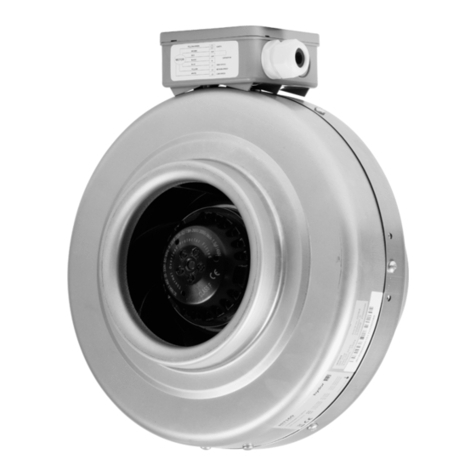
ELTA FANS
ELTA FANS Hydor HIT Series manual
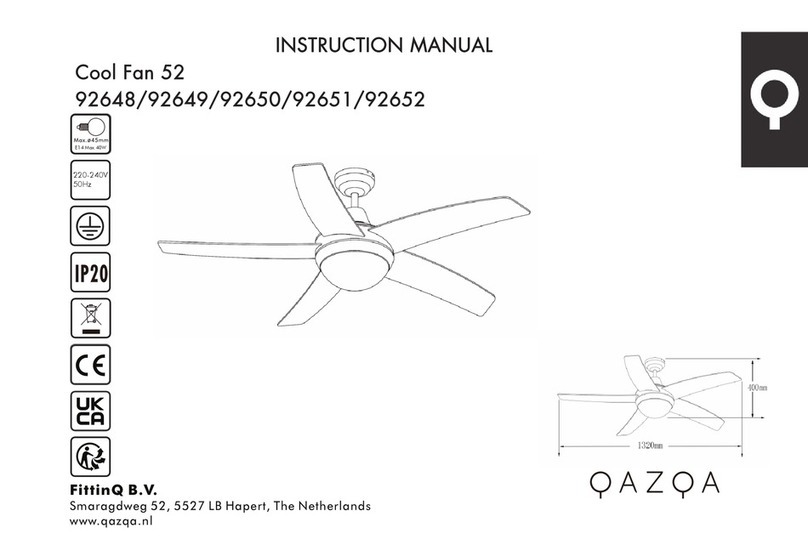
Qazqa
Qazqa 92648 instruction manual
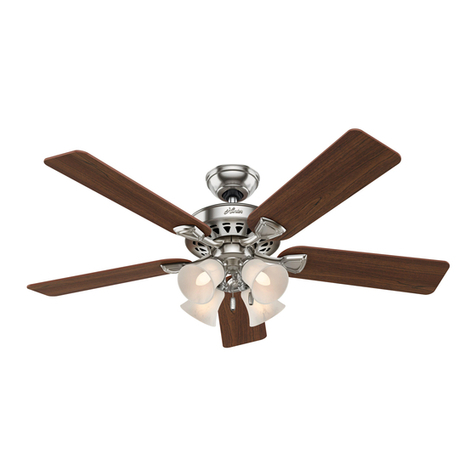
Hunter
Hunter Westminster Owner's guide and installation manual
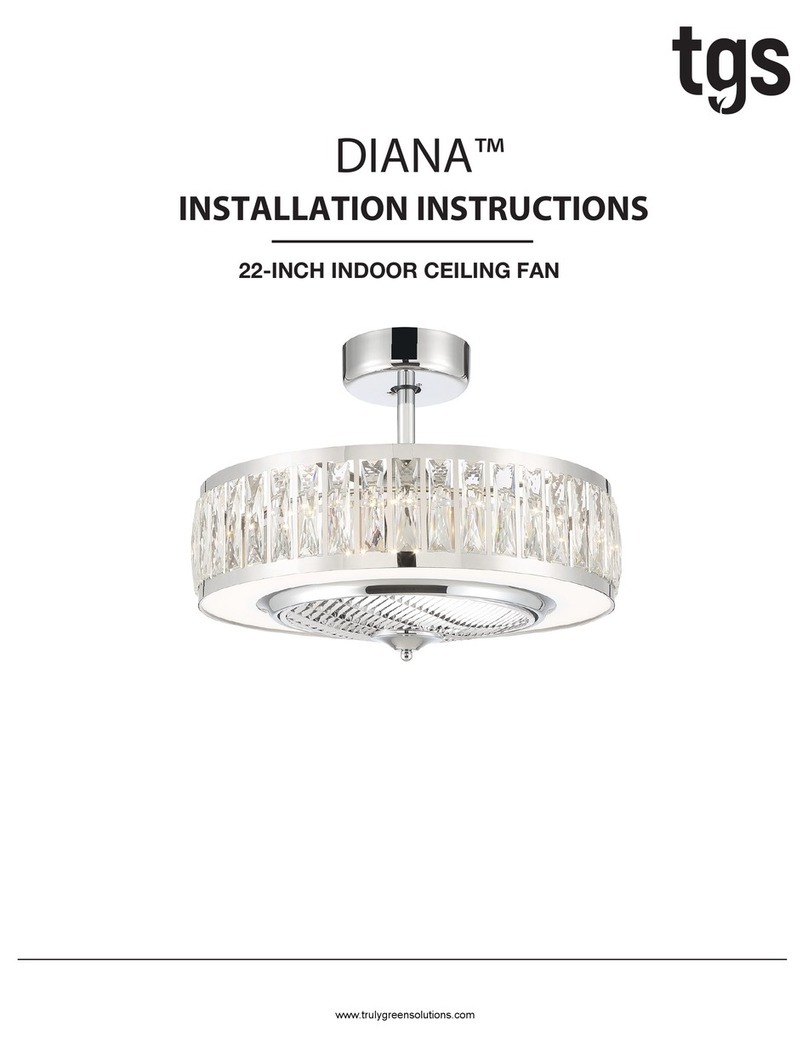
TGS
TGS DIANA Series installation instructions

Velleman
Velleman HQ-Power HQSM10009 user manual
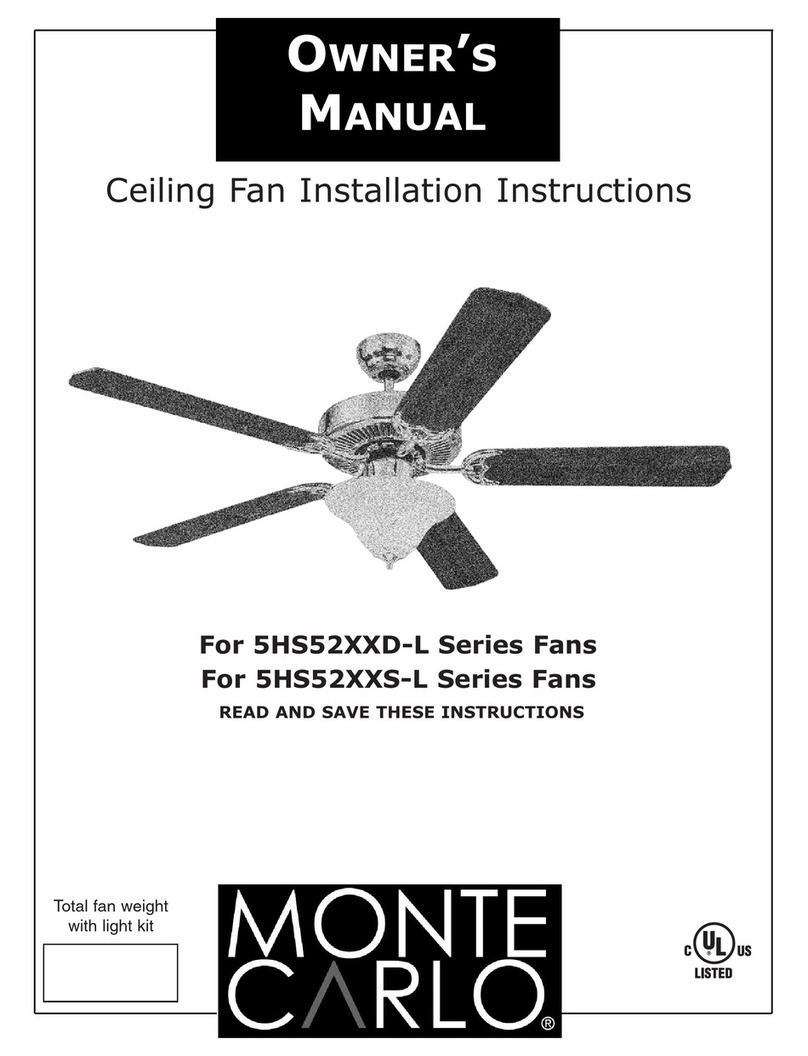
Monte Carlo Fan Company
Monte Carlo Fan Company 5HS52XXD-L Series owner's manual
